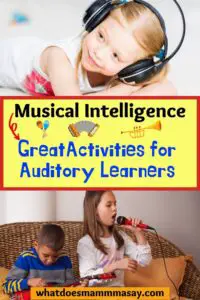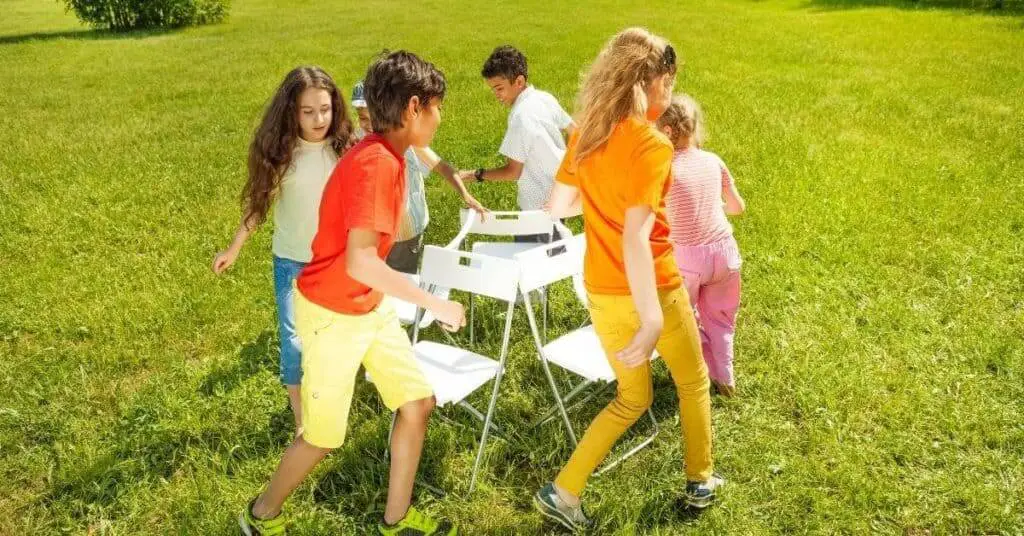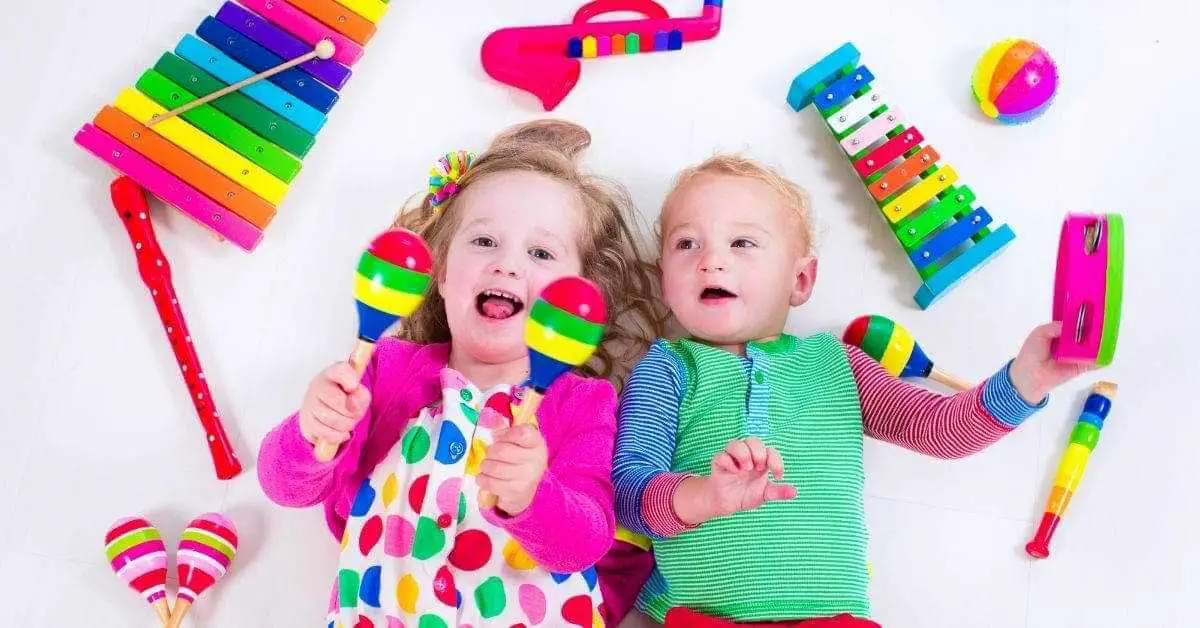In my almost 10 years as a teacher, I’ve encountered all kinds of students with different learning styles. Now, any teacher can tell you that there are certain students that you’ll remember forever for various reasons.
One such student for me was a 2nd grader who didn´t seem to process anything that was going on in the classroom. He’d either look at the ceiling, under his desk, talk to his closest colleague, or his pencil (yeah…I know), anything but listening to what I was saying.
In the beginning, I used to get annoyed with him, stop my lecture and try to get him to pay attention. However, I soon realized that he WAS PAYING ATTENTION after all. Every time I’d ask him to tell me what I’ve just said, he’d have no problem doing so. And so, I realized that I had an auditory learner on my hands. Even though he wasn’t looking at me, he was absorbing the information by listening to what I was saying.
I’ve had many students of all ages with musical intelligence and learnt a lot about how to teach them in a way that suits their auditory ability best.
In this post, I will share with you the best activities for auditory learners that can be used at home as well as in the classroom.
This post may contain affiliate links and I may earn a small commission when you click on the links at no additional cost to you. As an Amazon Affiliate, I earn from qualifying purchases. You can read my full disclosure here.
But before we look at some auditory learning activities…
What is musical intelligence?
The auditory intelligence is one of the eight intelligences or abilities identified by American developmental psychologist Howard Gardner in his 1983 book Frames of Mind: The Theory of Multiple Intelligences.
In a previous article, I have written more about The Multiple Intelligences Theory and How it can Help Your Child. I think you should check it out.
As the name suggests, auditory intelligence has to do with music, sound, and things that we can hear.
Thus, kids with an aural learning style (Auditory-Musical-Rhythmic style) process information best through music, tone, and sound. They have a higher ability to process and understand rhythm, identify patterns in sounds, understand the relationship between sounds and absorb auditory information.
How can you identify auditory learners?
Now that you know what auditory intelligence is all about, how do you know whether your child has musical intelligence or not? What are some of the musical intelligence characteristics?
- They love to sing and hum
- They often read aloud
- Listening to music is one of their favourite activities (music can have calming effects on them and generally bring them joy)
- They are skilled at playing musical instruments
- They have great rhythm
- They can often be seen humming, whistling a tune, or tapping
- They are good listeners
- They can easily memorize and replay songs
- Among their favourite school activities are music, performing in a band or choir
- Reading aloud is a good way of learning
These are just a few characteristics of a musically intelligent learner. Of course, each individual may display different traits but they will all revolve around sound, rhythm, tone, and sound patterns.
You can either observe your child in order to determine if s/he has an auditory intelligence or if the child is older, (can read and write) you can give him/her this simple test that will give you a clue.
Activities for Auditory Learners that will help them learn
1. Reading aloud
An auditory learner will absorb information much better by hearing it. Whether they hear it from another person or themselves. Reading aloud will allow them to hear the rhythm and pattern of the language, thus helping them remember the information with ease.
Reading aloud could involve individual reading (either the student himself or listening to another student reading), choral reading, or re-reading after listening to a model.
2. Listening to audiobooks and podcasts
We are lucky that nowadays more and more books are available in audio format. This will greatly benefit the musically intelligent as they will be able to listen and learn wherever they are. You will find a nice selection of audiobooks on Amazon for all ages (most are free if you have an Audible subscription– you can take advantage of their 30 days free trial period), Audible also has nice elementary stories for free, for younger kids, Storynory and (my personal favourite) Storyline Online have fantastic audio stories for little learners.
3. Using mnemonics
Mnemonics come in handy when we want to remember a concept with the help of letters, numbers, or associations. Mnemonics are especially helpful for auditory learners since they include rhymes, songs, poems, and acronyms. A famous example of mnemonics to remember the order of the planets is My Very Excited Mother Just Served Us Nine Pies (Mercury, Venus, Earth, Mars, Jupiter, Saturn, Uranus, Neptune). Learners can either use readily available mnemonics or make up their own.
4. Talking to themselves
Auditory learners are often spotted talking to themselves. Although it may look funny, hearing their own voice helps them put their thoughts in order and makes sense of their ideas.
5. Recording lessons and then replaying them
Nowadays the majority of phones have recording capability so musically intelligent students should totally take advantage of this.
Where allowed, auditory learners can record the lectures and then listen to them as many times as needed.
6. Associate music with ideas and key concepts
Each person is unique and so is the way they learn. Some people might remember things by interacting and touching them, other people’s memories are triggered by scent and for others, an image will help them learn easily.
For students with auditory intelligence, music and sounds will help a lot with learning and remembering ideas and key concepts. It might help to listen to a certain kind of music in the background when learning so that they associate a particular song to the concepts that they are reading.
7. Teaching what they have learnt
Have you ever seen your child gathering their dolls, stuffies, and action figures and transforming that space into a veritable classroom? It´s adorable, I know. But it´s also a great way, especially for an auditory learner, to recap the information heard at school. Encourage this type of role-playing and perhaps even take part in it as a student.
8. Discuss with someone or/and find a study buddy
Discussing the newly learnt information with someone can tremendously help the key points sink in. A study buddy not only makes the learning process fun but also very effective for the musically intelligent by hearing each other’s voices and taking turns in explaining ideas.
9. Singing/Rapping their notes and incorporating rhythm
One of the musical intelligence characteristics is that the people pertaining to this category are generally good at singing and have a good rhythm.
One thing that will help students with a musical intelligence learning style retain information easier is singing or rapping their notes. Transposing the written words into music will help the auditory learner remember the information easier. Similarly to making up a tune to remember their notes is playing with rhythm when reading them. Making unique combinations of long, short, stressed, and unstressed syllables will facilitate memorization.
10. Playing quiet background music
For some people, having background music while learning or working increases productivity. Of course, for others, it is a distraction. For an auditory learner, playing quiet background music might actually facilitate the learning process, making it more effective.

11. Giving oral presentations as opposed to written essays
Students should have the option to, depending on where their strengths lie, either submit a written essay or give an oral presentation. The latter will especially benefit students with auditory intelligence.
12. Storytelling and Role Playing
Incorporating those bland historical facts into an attractive story, or explaining that tricky grammatical rule through a funny story is an extraordinary tool not only for an auricular learner but for all students and should be used as much as possible.
Similarly, role-playing can be a valuable instrument to learn and revise information. Many students with different learning styles will benefit from this activity.
13. Record themselves talking about their ideas
Most of us use pen and paper to write down ideas so we don´t forget them. For an auditory learner, it might be more beneficial to record their ideas and then re-play them.
14. Reading Softwares
TTS (text-to-speech) programs can be very helpful for students with musical intelligence. Nowadays there are many programs and apps ranging from free ones to paid and subscription-based ones. Here is a list of TTS and OCR (optical character recognition) software and apps that you may find useful.
15. Participating in debates
Debates have so many benefits from the ability to organize a speech, deliver it effectively and develop reasoning skills to the ability to listen critically to what others have to say and respond accordingly.
Debates are great for all types of students, however, auricular learners are generally good at listening and delivering a speech with the right tone, rhythm, and pace.
16. Verbal Repetition
Repetition, in general, helps us learn and remember things. Students with musical intelligence will greatly benefit from listening to the target information multiple times.
Hands-on Activities for Auditory Learners

Let’s take a look at some fun “listening games” that are always a hit with kids in the classroom or at home. These games can be played with children as young as three all the way up to 10 years of age. Many are great as group games but can be as fun played in two or three players.
1. Simon says…
An absolute classic game that is incredibly fun and can be used to introduce or revise lesson topics as warmer or cooler. It is a great game both for kinesthetic learners and for auditory learners.
Instructions: One person is Simon and will give the other players commands. Some examples of commands are: jump on one leg, touch something yellow, spin around, shake someone´s hand, open your book, take one step to the left/right, etc.
The players have to listen carefully. If “Simon” starts his/her sentence with Simon says…(clap your hands) everybody has to do that action. However, if “Simon” gives a simple command without Simon says… at the beginning, all the players have to sit still and not do the action. The player(s) that do the action when they are not supposed to, is out of the game.
2. Chinese Whispers
This game is best to be played in a larger group, with at least 4-5 players. The more players the more fun it will be and the more hilarious the end result.
Instructions: All players sit in a line next to each other. One of the players sitting at the end of the line will whisper a word to the player next to him/her. That player will then have to whisper the same word (or whatever s/he understood) to the next player and so on until they reach the last player in line. That player will have to say the word out loud and see if it´s the same as the initial word.
For older children, you can ask them to whisper an entire sentence to make the game more challenging.
3. Guide me to the treasure
This is a great game for giving and following instructions and also learning to trust the person next to you.
Instructions: Before the game starts, hide an object (previously agreed upon) somewhere in the house/classroom. The players pair up. One child will be blindfolded and the other one will give instructions and guide. Some instructions could be: take three steps forward; turn left and take two big steps; bend down low and walk like this until i say stop, etc. The aim of the game is for the blindfolded player to get to the hidden object.
For younger children, I would either play without the blindfold or remove all of the potentially dangerous obstacles.
4. Hello, who is it?
I used this game as a warmer and a fun ice-breaker. It is simple, doesn´t require any previous set-up and kids love it. It is best played in a larger group.
Instructions: One child will stand with his/her back to the group. Alternatively, you can also use a blindfold. One of the kids from the group will say “Hello” and the player with the back to the group will have to guess who that child was.
If you want to make the game a little bit more challenging and if the children are quite familiar with each other, I would ask the player to say “Hello” using a funny voice.
Depending on the age of the kids you can give them a few tries to guess the name of the player who said “Hello”.
5. The Magic Word
I love this game because it involves songs, movement, and listening.
Instructions: Before playing the chosen song, decide on a few words from the song and the actions that kids will do when they hear those words.
Let´s take for example Twinkle, Twinkle Little Star. Tell the children that whenever they hear “star” they should jump once, for “are” clap their hands, for “above” stomp their feet, “sky” wave in the air. Play the song and do the actions whenever they hear the “magic words”.
For younger kids, I would start with just one magic word and add more as we go.
6. Chain Story
Another classic game that will practice vocabulary, auditory skill, concentration, and imagination.
Instructions: The activity is pretty simple and doesn´t require any previous set-up (unless you want to introduce some visual props). One player starts by saying the opening sentence of the story. The next player will continue the story by saying another sentence. Based on the first two sentences, the third player continues the story and so on until the last player adds the finishing sentence.
If there are few children playing the game go around two-three times to make the story longer. If you wish you can ask the players to add more than one sentence at a time. You can give each player photos and ask them to make sentences based on them. Or give them some keywords that they must use in their sentences. There are many variations that you can add to this fun game.
7. The Noisy Bag
Instructions: Put some noise-making objects in a bag. These could be: a bell, tambourine, a squeaky toy, a rustling plastic bag, a bottle of water, etc. One by one, the students will have to guess the objects in the bag by listening to the sounds that they make.
8. The chain of instructions
An extremely simple game that can be played with any objects at hand and in as little as two players (one gives the instructions and the other executes them) or a whole classroom of children.
Instructions: First, decide on the objects that you are going to play with. Depending on the age of the players, there can be more or fewer objects. One player will give the others a chain of commands that they must do. For example, put the pencil in the book, put the coin on your shoulder, and the book under the chair. The other players have to listen carefully and do the action in order.
Again, depending on the age of the players more instructions can be given at one time or less.
9. Musical Statues
Another classic listening game that kids go crazy for. It is also great because it addresses different abilities. It will be enjoyed by kinesthetic learners, kids with an auditory intelligence but also verbal-linguistic children.
Instructions: Prepare some songs that the kids love or the song that you are teaching/revising. While the players hear the song they have to move around and dance. As soon as the song stops, everybody has to freeze. The player that moves while the music is off, is eliminated.
When playing this game with younger kids, my suggestion is not to eliminate them in order to avoid tears. Instead, you can either ask them to sit down for one round or simply tell them to dance in another part of the room, away from the group.
10. Musical chairs

Musical chairs are somewhat similar to musical statues in the sense that there is music and children dance or walk. The difference is when you stop the music.
Instructions: Before the game starts, arrange some chairs in a circle with the seats facing outwards. You should have one less seat than the number of players. While the chosen song plays, the children will walk and dance around the chairs. They must not sit still in front of a chair ready to pounce on it. When the music stops, the players must quickly sit down on a chair. Since there is one less seat, one child will remain standing and will be eliminated. The game continues by removing one chair. At the end of the game, you will have one chair left and two players “battling” to sit down.
Like with Musical statues, when playing this game with younger children, I wouldn´t eliminate them but rather ask them to sit down for one round and then go back in the game.
11. Red light Green light
This is one of my childhood games that I used to play a lot with my friends. It involves a lot of movement, listening, and reaction speed.
Instructions: One player is chosen to be “the traffic light” and will stand some distance away from the rest of the group with his/her back turned. The other players stand in a line facing “the traffic light”.
When the traffic light says “green light” all the other players start moving towards him/her. When the traffic light says “red light” and turns around, all the other players must freeze. If anyone moves while the traffic light is looking, they are out of the game.
The game continues in the same manner until one of the players reaches the traffic light and taps him/her on the shoulder. That player will become the traffic light.
12. Fruit Salad
I used to play this game a lot with my preschool kids and they loved it. I slightly modified it to revise certain topics like colours, farm animals, days of the week, etc. It is best to have more players for this game, I would say at least 5.
Instructions: Have the kids sit down in a circle. Start by saying two names. Those two children will have to quickly stand up and swap places. Start slowly and increase the pace as the game progresses. You can even start calling our three names at a time.
This is a great game for the beginning of the year as a warmer, as it helps kids get to know each other´s names.
If you want to use Fruit Salad as a fun revision game, simply assign each child a word from the revised topic, and instead of using their names, call them by those words.
13. What´s the time Mr. Wolf?
I thought I´d finish this list with another beloved classic. What´s the time Mr. Wolf is best played in a larger group but it can be played in a little as three children.
Besides being ridiculously fun, it´s a great game to practice numbers and the clock.
Instructions: One child will be Mr. Wolf and will stand some distance away from the other players. Also, assign a safe place where the players can run to (a circle or a line behind which they will be safe from the wolf). One more thing before the game starts is to decide on an hour, say, 6 o’clock, when Mr. Wolf will have his/her dinner and chase the other players.
The children will ask Mr. Wolf: What´s the time, Mr. Wolf? Mr. Wolf will answer with a number: It´s 3 o’clock!
The children will have to take 3 steps towards the wolf (you can also decide upon the manner in which the players move- hop, ant steps, leap like a frog, etc).
The game continues until the wolf says “It’s 6 o’clock” at which point s/he will chase the other players. Everybody will try to make it to the safe spot, however, the player that is caught by the wolf, becomes the new Mr. Wolf and the game starts again with a new dinner time.
Is your child not an auditory learner? Check out these other posts on Multiple Intelligences:
Activities for Kids with Intrapersonal Intelligence
The Best Activities for Bodily-Kinesthetic Learners
The Best Activities for Visual-Spatial Learners
Fun Activities for the Verbal-Linguistic Learner
The Best Activities for the Logical-Mathematical Intelligence
How Can the Multiple Intelligences Theory Help your Child?
11 Existential Intelligence Activities for Children
Interpersonal Intelligence Activities for Kids
I hope this list gives you some inspiration on fun activities for auditory learners (many can be used for kinesthetic learners and other types of intelligences as well) but also some learning strategies for kids with musical intelligence.
If you enjoyed this post, please share it with your friends:)

Mom of two wonderful children, dedicated teacher and book lover.



This is great information. As a previous K teacher I can say that I have experience auditory learners as well and these tips will really help some of them. Thanks for sharing!
I think my daughter might be an auditory learner. She’s only 4, but she loves to sing and she’s constantly talking to herself. She’ll even parrot us, which makes us laugh as she’ll repeat the weirdest things we say.
This is so informative and I think my daughter is a bit auditory learner because she is always reading out loud and always playing music while doing her homework or even reviewing her lesson.
Great information and I love the activity ideas
My daughter is definitely and auditory learner. These are such great tips!
Thank you for sharing this. I never even thought that this would be how someone would learn but I love how you broke it down and made it make sense.
a very cool collection of activities and tips for parents and educators everywhere.. thank you
So informative! I love this collection of ideas and suggestions.
Hi Heather! I am glad that you found the post informative. Thank you for stopping by 🙂
This was so interesting and informative. These are so great tips. Thanks, for sharing.
Hi Aliya. I am so glad that you found the post useful. Thank you for reading!